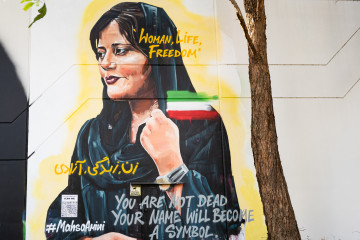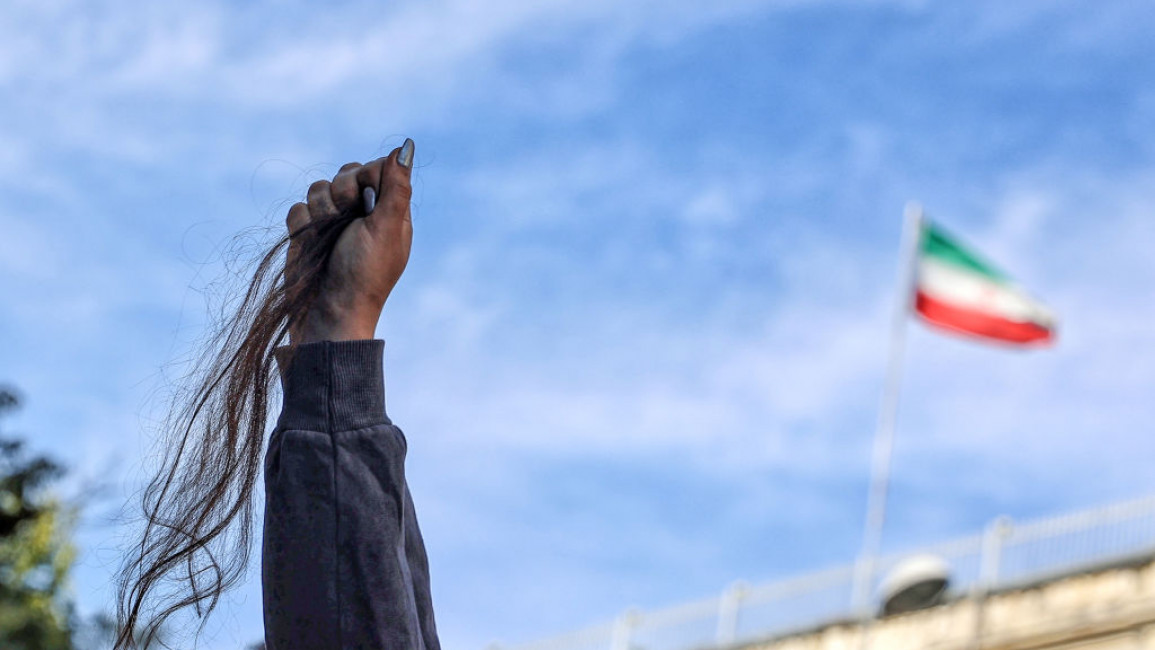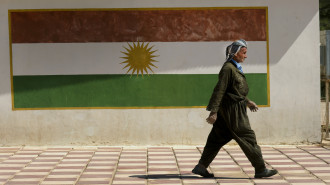

On 16 September 2022, Mahsa Jina Amini’s death in police custody sparked a social movement in Iran that still has the Islamic regime in trepidation.
The widespread women-led protests dubbed ‘Woman, Life, Freedom’ were against the mandatory hijab but also united around issues concerning wider societal issues and Iran’s different ethnic groups.
Simply put, Iranians wanted equality and a decent quality of life.
“We are not just talking about political rights; we are talking about a lack of life. Normal life, dignity. You cannot think, you cannot laugh, you cannot dance, you cannot marry who you want,” Asieh Amine, an Iranian activist and former journalist, told The New Arab, recounting the motivations of protesters.
Over the past year, TNA has spoken with Iranian women activists representing the intersections of Iran’s society, discussing the movement’s momentum and future under Iran’s new reformist President Masoud Pezeshkian.
With the movement’s second anniversary approaching, and following the regime’s brutal crackdown on protesters, some have pinned their hopes on the new Iranian president for change. But is this ill-judged?
Hopes for change in Iran
Iran’s election took place amid widespread apathy in the political system and a lack of unity among the conservative camp. Known for a relatively moderate stance and occasional criticism of hardline policies without ‘rocking the boat’, Pezeshkian appealed to voters seeking change.
During debates, Pezeshkian indicated he did not support institutionalising the mandatory hijab. “I guarantee that the entire government will stand firm against mandatory patrols (for hijab), internet filtering, and external pressures in all sessions,” he was reported as saying.
Now in power, however, pressure is mounting from hardline lawmakers for a mandatory hijab law with more stringent enforcement mechanisms, monitoring, and penalties.
Supreme Leader Ayatollah Ali Khamenei's pre-approving of all cabinet picks in the new government could also indicate how much change can be expected from the government. This could leave little room for serious reforms.
Some who voted for the reformist candidate also now believe that his promises were likely just lip service, even if his victory symbolised a rejection of the hardline elements of the regime.
Others point to his lack of direct support for the ‘Women, Life, Freedom’ movement when it first took hold in Iran, condemning the violence against it but wanting the hijab law to be respected.
The rights of all Iran's citizens
The ‘Woman, Life, Freedom’ protests were about more than the mandatory hijab. Rather, that became the focal point for wider oppressive policies and the economic situation. The treatment of minority groups, as well as their power to protest, was also magnified during the 2022 uprising.
Marked by unprecedented unity across gender, ethnic, and social lines - reflecting a growing resistance to government tactics of division - the global Iranian diaspora further amplified the movement.
Shler Bapiri, a 36-year-old Kurdish human rights activist originally from the Iran-Iraq border, says the role of the Kurds, especially, was at the forefront of the struggle.
“The Islamic regime of Iran today has always feared the Kurds and their movement and considered them a threat to its power,” she told TNA.
“Unfortunately, this is why the Islamic Republic used the heaviest weapons against civilians in the ‘Women, Life, Freedom’ movement, before and after it. They are afraid of the Kurds and their struggle.”
Shne Hedati, 64, fled Iran due to political persecution and is now living in Sweden. She adds that “Kurdish women have been at the forefront of resisting oppression, not only against the Iranian regime but also in the struggle for gender equality”.
Other ethnic groups’ heightened long-standing grievances and mobilisation during the 2022 protests also included Baluchistan’s plight.
However, the regime’s exclusionary policies, lack of representation for minorities, and systematic discrimination underscore a deep-rooted oppression that will persist unless “future governance in Iran genuinely recognises and protects the rights of all its citizens,” according to Hedati.
|
|
The movement is alive but subdued
As notable as the mass mobilisation of the movement was, the government’s violent crackdown on protesters together with a lack of leadership of the movement itself, a divided opposition, and insufficient international support, has kept it subdued.
“Concessions from powerful countries, which have taken no significant action against the regime and their superficial, hypocritical stances have further weakened the movement,” said Hedati.
“The destructive roles of China and Russia, and the European countries willing to protect their economic interests by, for example, handing over a mass murderer like Hamid Nouri - have significantly undermined the movement,”
In 2022, Nouri, a former prison official, was sentenced in Sweden for his role in the mass executions of political prisoners in Iran in 1988 but was pardoned by the Swedish government and returned to Iran this year, a move criticised by human rights advocates.
Women and environmental activist Kawsar Fattahi, a Peshmerga and member of the central committee of the Komala Party of Iranian Kurdistan, herself had to flee Iran due to threats from the Islamic Revolutionary Guard Corps (IRGC).
But despite the severe suppression by the regime, Fattahi notes a cultural shift in Iran regarding women’s rights and the rejection of the mandatory hijab law.
“This is like a chess [game] between the IRGC, the regime, and the people. I think the movement is still there; the movement is alive but the matter is with the power of the suppression by the IRGC and how people can succeed in destroying this power and making it weak.”
However, relying on Pezeshkian to introduce significant reforms would be a mistake.
“First, it is essential to understand the mission of Pezeshkian and the reasons behind Khamenei’s support for him,” says Fattahi.
“Pezeshkian’s role is not to implement any meaningful reforms but to protect the regime. Following the [Mahsa Amini] revolution, the regime recognised that it was on a path toward its eventual downfall. To counter this, they needed someone who could appear as a reformist - someone who could control the reformist faction while simultaneously deceiving the world into believing there was a willingness to negotiate. This strategy was intended to buy the regime more time.”
She refers to the statistics: since June’s election, 87 executions have been reported. Women have also faced increased restrictions and oppression following former Iranian President Ebrahimi Raisi’s death.
Despite this, Fattahi says that “the spirit of revolution is still very much alive and it continues in various forms,” pointing to the broad boycott of the elections, refusal to comply with repressive rules, and even continued resistance in prisons.
"Pezeshkian's role is not to implement any meaningful reforms but to protect the regime"
Clear scepticism still exists regarding change in the Islamic Republic but Mostafa Hashemitaba, a former minister in president Khatami’s administration and an advisor in president Rouhani’s government, believes the ‘Women, Life, Freedom’ movement is not anathema to the new government.
“Naturally, no one would oppose these three words,” he says. “Mr Pezeshkian, too, would strive to enhance all three aspects: elevating women’s status, promoting lawful freedom for all without exploitation or chaos and ensuring a good quality of life for all citizens. His efforts would aim to achieve these goals without encouraging misconduct, anarchy or disorder."
However, he concedes that expectations of progress in gender equality should be managed.
“It’s clear that in some cases, women’s rights aren’t exactly equal to men’s rights, which Mr Pezeshkian will address but it seems complete equality of rights between women and men won’t be achieved, as is the case in all countries.”
Sophia Akram is a researcher and communications professional with a special interest in human rights, particularly across the Middle East.
Follow her on Twitter: @mssophiaakram




 Follow the Middle East's top stories in English at The New Arab on Google News
Follow the Middle East's top stories in English at The New Arab on Google News


